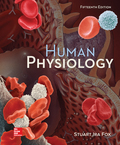
EBK HUMAN PHYSIOLOGY
15th Edition
ISBN: 9781260163049
Author: Fox
Publisher: MCGRAW HILL BOOK COMPANY
expand_more
expand_more
format_list_bulleted
Concept explainers
Textbook Question
Chapter 18, Problem 41RA
Refer to figure 18. I 4 to answer the following questions.
About how long does each slow wave last (what is its duration)?
Expert Solution & Answer
Want to see the full answer?
Check out a sample textbook solution
Students have asked these similar questions
4. This question focuses on entrainment.
a. What is entrainment?
b. What environmental cues are involved in entrainment, and which one is most influential?
c. Why is entrainment necessary?
d. Assuming that a flash of darkness is an effective zeitgeber, what impact on circadian
rhythms would you expect to result from an event such as the 2024 solar eclipse (assume
it was viewed from Carbondale IL, where totality occurred at about 2 pm)? Explain your
reasoning. You may wish to consult this phase response diagram.
Phase Shift (Hours)
Delay Zone
Advance Zone
Dawn
Mid-day
Dusk
Night
Dawn
Time of Light Stimulus
e. Finally, give a real-world example of how knowledge of circadian rhythms and
entrainment has implications for human health and wellbeing or conservation biology.
This example could be from your reading or from things discussed in class.
Generate one question that requires a Punnet Squre to solve the question. Then show how you calculate the possibilities of genotype and phenotype
Briefly state the physical meaning of the electrocapillary equation (Lippman equation).
Chapter 18 Solutions
EBK HUMAN PHYSIOLOGY
Ch. 18 - Prob. 1aCPCh. 18 - Describe the structure and function of the mucosa,...Ch. 18 - Prob. 2bCPCh. 18 - Describe the structure and function of the lower...Ch. 18 - Prob. 3bCPCh. 18 - Prob. 4aCPCh. 18 - Explain how peptic ulcers are produced and why...Ch. 18 - Explain how gastrin and vagus nerve stimulation...Ch. 18 - Describe the adaptations of the small intestine...Ch. 18 - Prob. 6CP
Ch. 18 - Prob. 7CPCh. 18 - Prob. 8aCPCh. 18 - Prob. 8bCPCh. 18 - Prob. 9CPCh. 18 - Prob. 10aCPCh. 18 - Prob. 10bCPCh. 18 - Prob. 10cCPCh. 18 - Prob. 11aCPCh. 18 - Prob. 11bCPCh. 18 - Prob. 12CPCh. 18 - Prob. 13aCPCh. 18 - Describe the mechanisms involved in the intestinal...Ch. 18 - Prob. 14CPCh. 18 - Prob. 15CPCh. 18 - Prob. 16aCPCh. 18 - List each enzyme involved in protein digestion....Ch. 18 - Describe how bile aids both the digestion and...Ch. 18 - Trace the pathway and fate of a molecule of...Ch. 18 - Prob. 17cCPCh. 18 - Which of these statements about intrinsic factor...Ch. 18 - Prob. 2RACh. 18 - Which of these statements about gastric secretion...Ch. 18 - Prob. 4RACh. 18 - Which of these statements about trypsin is...Ch. 18 - Prob. 6RACh. 18 - Prob. 7RACh. 18 - The first organ to receive the blood-borne...Ch. 18 - Prob. 9RACh. 18 - Prob. 10RACh. 18 - Prob. 11RACh. 18 - Which of these statements about vitamin is...Ch. 18 - Which of these statements about starch digestion...Ch. 18 - Prob. 14RACh. 18 - Which of these statements about contraction of...Ch. 18 - Prob. 16RACh. 18 - Prob. 17RACh. 18 - Which of the following statements about the liver...Ch. 18 - Prob. 19RACh. 18 - Prob. 20RACh. 18 - Prob. 21RACh. 18 - Describe the mechanisms that are believed to...Ch. 18 - Prob. 23RACh. 18 - Explain how jaundice is produced when (a) the...Ch. 18 - Prob. 25RACh. 18 - Distinguish between chylomicrons, very-low-density...Ch. 18 - Prob. 27RACh. 18 - Trace the course of blood flow through the liver...Ch. 18 - Prob. 29RACh. 18 - Describe the reflexes controlling the stomach,...Ch. 18 - Prob. 31RACh. 18 - Prob. 32RACh. 18 - Prob. 33RACh. 18 - Prob. 34RACh. 18 - Prob. 35RACh. 18 - Prob. 36RACh. 18 - Prob. 37RACh. 18 - Prob. 38RACh. 18 - Prob. 39RACh. 18 - Prob. 40RACh. 18 - Refer to figure 18. I 4 to answer the following...Ch. 18 - Prob. 42RACh. 18 - Prob. 43RA
Knowledge Booster
Learn more about
Need a deep-dive on the concept behind this application? Look no further. Learn more about this topic, biology and related others by exploring similar questions and additional content below.Similar questions
- Explain in a small summary how: What genetic information can be obtained from a Punnet square? What genetic information cannot be determined from a Punnet square? Why might a Punnet Square be beneficial to understanding genetics/inheritance?arrow_forwardIn a small summary write down:arrow_forwardNot part of a graded assignment, from a past midtermarrow_forward
- Noggin mutation: The mouse, one of the phenotypic consequences of Noggin mutationis mispatterning of the spinal cord, in the posterior region of the mouse embryo, suchthat in the hindlimb region the more ventral fates are lost, and the dorsal Pax3 domain isexpanded. (this experiment is not in the lectures).a. Hypothesis for why: What would be your hypothesis for why the ventral fatesare lost and dorsal fates expanded? Include in your answer the words notochord,BMP, SHH and either (or both of) surface ectoderm or lateral plate mesodermarrow_forwardNot part of a graded assignment, from a past midtermarrow_forwardNot part of a graded assignment, from a past midtermarrow_forward
arrow_back_ios
SEE MORE QUESTIONS
arrow_forward_ios
Recommended textbooks for you
 Human Biology (MindTap Course List)BiologyISBN:9781305112100Author:Cecie Starr, Beverly McMillanPublisher:Cengage Learning
Human Biology (MindTap Course List)BiologyISBN:9781305112100Author:Cecie Starr, Beverly McMillanPublisher:Cengage Learning





Human Biology (MindTap Course List)
Biology
ISBN:9781305112100
Author:Cecie Starr, Beverly McMillan
Publisher:Cengage Learning

The Cell Cycle and its Regulation; Author: Professor Dave Explains;https://www.youtube.com/watch?v=eqJqhA8HSJ0;License: Standard YouTube License, CC-BY
Cell Division - Mitosis and Meiosis - GCSE Biology (9-1); Author: Mr Exham Biology;https://www.youtube.com/watch?v=w7vp_uRA8kw;License: Standard YouTube License, CC-BY